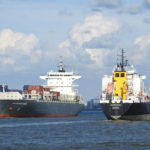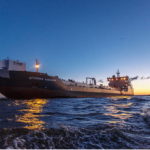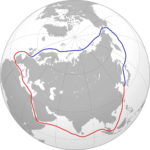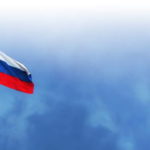Despite and because of political and economic challenges the country is facing, Russia’s government puts special emphasis on developing the maritime industry. Arctic shipping and the »Ice Silk Road« play an important role
According to official statements, projections for volumes along Russia’s Northern Sea Route (NSR) heat up as the first Yamal gas[ds_preview] carrier tests the waters in a voyage to South Korea, while China and Russia reach agreement to exploit the »Ice Silk Road«. Before the recent G20 Summit in Hamburg, President Xi Jinping of China visited Russia to sign an agreement dubbed, identifying Russia’s Northern Sea route as key to future cooperation between the two nations.
Moscow intends to drive the nations raw materials export drive eastward and China is not the only Asian economy hoping to benefit. As the largest importer of liquefied natural gas in the world, Japan’s commitment to the massive Yamal LNG project was made explicit in 2014, when the Japanese Bank for International Co-operation brokered a 400mill. $ financing package to ensure completion.
At the end of July 2017, for example, the world’s largest icebreaking tanker, »Christophe de Margerie«, departed from Norway’s Hammerfest LNG plant headed for South Korea, on its first commercial voyage via the NSR. The Arc7 ice-class vessel is the first of 15 vessels envisaged for Yamal LNG, with first liftings expected in October. In Korea, the vessel will deliver a cargo for Total Gas & Power, the company announced, adding that it is the first unescorted merchant LNG vessel ever to take this route, »which makes it possible to reach Asia via the Bering Strait in 15 days versus 30 days via the Suez Canal.«
In 2016, NSR traffic grew by 35%, reaching 7.27mill. t overall, officials say. Sovcomflot Chief Executive, Sergey Frank was recently quoted by news agency TASS, forecasting that the shipping company’s total NSR oil shipments in 2018 would reach 12mill. t. Meanwhile, the Russian Ministry of Transport still forecasts NSR volumes by 2020 will reach 65mill. t per year.
While the Yamal LNG carriers are intended to operate unassisted from July to December, converting overall NSR traffic projections into reality will rely on icebreaker support, along a route where average ice thickness exceeds 1.6m from December to June. Today, requirements are mostly served by four Arktika-class nuclear icebreakers, the newest of which is the »50 Let Pobedy«, completed in 2007. The others, »Yamal«, »Sovetskiy Soyuz« and »Rossiya«, date from 1993, 1990 and 1985 respectively.
The need for fresh icebreaking tonnage is therefore becoming acute. Dmitry Fishkin, Deputy Director of the Department for the Development of Interregional and Cross-Border Cooperation of the Economic Development Ministry, has suggested that the need will be urgent by 2021, as NSR oil and gas volumes ramp up.
In fact, three new icebreakers are under construction at United Shipbuilding Corp, with delivery now due one apiece in 2019, 2020 and 2021. The LK-60Ya-class nuclear-powered vessels will be able to cut through 2.8m-thick ice. Two more vessels of the same type are already planned, as well as a LK-110Ya »Leader-class« vessel to break winter ice up to 4.3 m, and 2.5m-thick ice continuously at 10 kn.
At a recent meeting with Prime Minister Dmitry Medvedev, Sovcomflots CEO Sergey Frank called for the Russian government to continue its drive to improve navigational safety measures on the NSR and for a ban on substandard ships and crews sailing in the environmentally sensitive region. He stressed the necessity of taking additional measures to ensure navigation safety along the NSR given the significant growth of freight traffic in that area.
Sovcomflot said in a statement that in 2018, just the two energy projects in the Gulf of Ob (Novy Port and Yamal LNG), both served by SCF vessels, »are expected to generate around 11.5mill. t of freight alone, almost doubling the Soviet-era NSR peak record of 6.6mill. t in 1987.«
»On behalf of the maritime community«, Frank expressed a hope that the Russian government will maintain the rate at which NSR infrastructure is being improved to ensure that the existing navigation safety measures remain adequate to the needs of the growing vessel traffic. This includes consistently developing the navigational and hydrographic support system, boosting the readiness of rescue services, and improving the reliability of navigational and communications aids.
Privatisation?
Frank stated that as of the end of 2Q 2017, over 200mill. t of crude oil and more than 16 mill. t of liquefied natural gas have been transported by SCF vessels for energy projects operating in the Arctic seas (Varandey, Prirazlomnoye, Novy Port) and in the Russian Far East (Sakhalin-1, Sakhalin-2) since the company began focusing on long-term project-based energy transportation and offshore servicing in 2006. During the first half of 2017 alone, Sovcomflot vessels transported 17mill. t of crude oil from the Russian Arctic and the Russian Far East to consumers.
During the meeting, Medvedev gave assurances that the government will fulfil all its obligations to support the pace of development of NSR infrastructure, including icebreakers and navigational aids.
The undertaking brings efforts by Russia’s shipbuilding segment to meet its icebreaker commitments on time to the top of the agenda at NEVA 2017, the biennial gathering of the international maritime community in Russia’s capital of the North. With reports emerging that the delivery of »Arktika« will be delayed, new momentum will be brought to a seminar on auxiliary vessels and a special session to advance internationally-sourced localisation of shipbuilding and ship equipment manufacturing in the Russian Federation.
»Shturman Albanov«
Recognition as the European Marine Engineering Awards’ ›2016 Ship of the Year‹ for the Sovcomflot Arctic shuttle tanker »Shturman Albanov« symbolizes the transformation underway in Russia’s maritime industry, but events in early May 2017 demonstrate the substance behind the symbolism.
Classed by the Russian Maritime Register of Shipping, the Arc7 ice-class ship is said to be the first tanker in the world designed for year-round transportation of hydrocarbons from the Gulf of Ob. The tanker is also the first ship in RS class to have certification compliant with the Polar Code. Its technical characteristics enable effective operation at temperatures up to –45° C. Two Azipod azimuth thrusters with total capacity of 22 MW and Double Acting Tanker (DAT) functionality allow the ship to sail through heavy ice up to 1.8 m thick when moving astern. The tanker is the lead ship in six designed to carry crude from the Yamal Peninsula to the port of Murmansk.
Focus on fishery industry
Another important segment for Russia’s maritime community is the fishing industry. The urgent need to modernise Russia’s fishing fleet has also encouraged a strong presence of Norwegians, with Innovation Norway, the Norwegian-Russian Chamber of Commerce and the Norwegian Russian Consulate occupying a new Norwegian National Pavilion. Ten of the 18 participating companies are active in either vessel building or fishery fleet equipment.
Murmansk-based company Nord Pilgrim is one of the fishery players. Two new trawlers are currently being built at the PJSC shipyard in Vyborg. The technology group Wärtsilä has been contracted to provide the engines and the complete propulsion package, including the propulsion control system.
The 80 m long trawlers will be reinforced to Ice 3 class, thereby enabling them to extend their fishing operations in the Barents Sea and North Atlantic.
Wärtsilä’s full scope of supply is for each ship one 8-cylinder Wärtsilä 32 main engine, one Wärtsilä gearbox, one Wärtsilä controllable pitch propeller system, one transverse thrusters system, and a Wärtsilä ProTouch propulsion control system. Auxiliary generating power will be supplied by one 6-cylinder and one 4-cylinder Wärtsilä 20 Auxpac engine. The equipment is scheduled for delivery to the yard in March 2018 and January 2019.

























